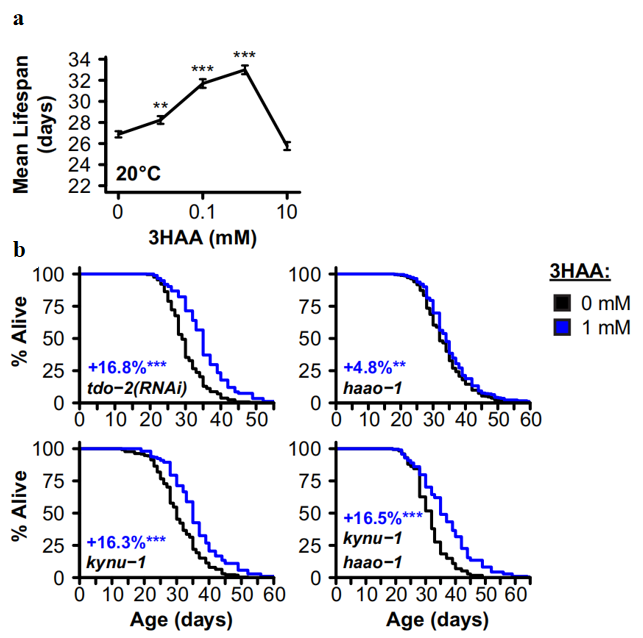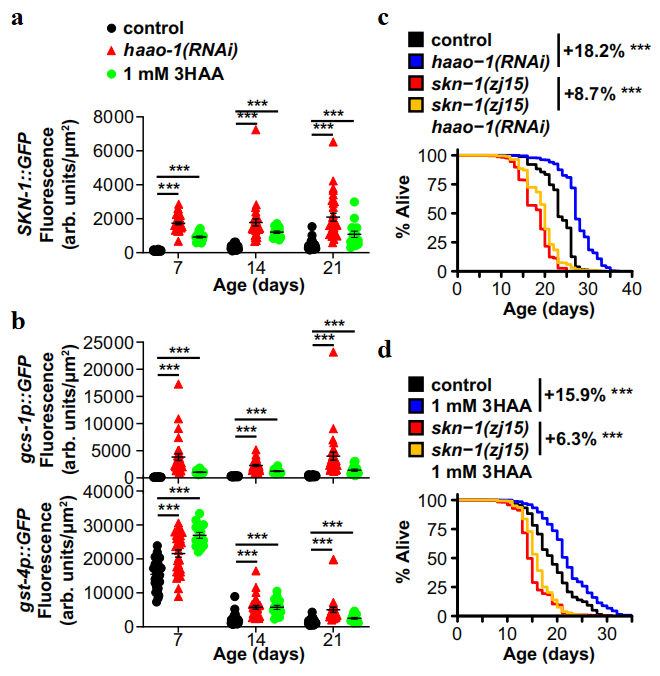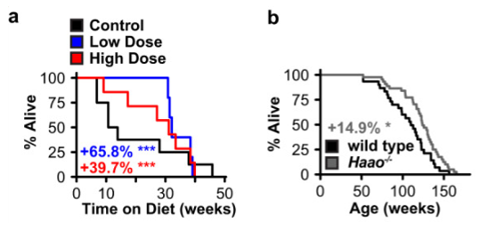Unlocking Longevity: The Role of 3-Hydroxyanthranilic Acid (3HAA) in Aging
2025-05-07 17:18
Keywords
3-hydroxyanthranilic acid (3HAA), Aging, 3-hydroxyanthranilic acid dioxygenase (HAAO), Oxidative stress, Lifespan extension
Contribution of SunyBiotech:
SunyBiotech is very honored to provide strain construction services for this study.
Strains haao-1(syb2665)::wrmscarlet (PHX2665) and kynu-1(syb2691)::wrmscarlet (PHX2691) were created for this work using CRISPR/Cas9 precise gene insertion by SunyBiotech Corporation.
Introduction
Aging is accompanied by systemic physiological changes, many of which increase vulnerability to chronic diseases such as neurodegeneration, cancer, and cardiovascular disorders. Metabolism, particularly of essential amino acids like tryptophan, has emerged as a critical modulator of the aging process. Notably, the kynurenine pathway, which degrades tryptophan into various metabolites including NAD⁺, has been linked with age-associated pathologies due to its roles in redox homeostasis and immune regulation. A recent study centered on the metabolite 3-hydroxybenzoic acid (3HAA) and its enzyme regulator 3-hydroxybenzoate dioxygenase (HAAO), exploring a key branch of this pathway. Their findings indicate that elevating 3HAA levels by inhibiting HAAO results in a significant extension of lifespan and enhanced stress resistance in C. elegans, with promising preliminary outcomes observed in murine models as well.
3HAA mediates haao-1 lifespan extension in C. elegans
Building upon prior discoveries that knocking down kynurenine pathway genes like tdo-2, kynu-1, and acsd-1 extends lifespan in invertebrates (Figure 1a), the authors turned their attention to haao-1, which encodes the enzyme HAAO. They performed RNA interference (RNAi) on C. elegans to reduce haao-1 expression and observed ~30% increase in lifespan (Figure 1b).Beyond lifespan, the researchers measured various indicators of healthspan. Worms with haao-1 knockdown retained greater body size, maintained mobility at older ages, and resisted declines in thrashing frequency in liquid (Figure 1c-d). Interestingly, the lifespan-extending effects were prominent when haao-1 was inhibited in neuronal and hypodermal tissues, indicating tissue-specific relevance. Importantly, reproductive potential was not negatively affected, and the benefits were observed across a range of temperature conditions, further supporting the robustness of this intervention (Figure 1e-g).

Figure 1. Knockdown of haao-1 extends healthy lifespan in C. elegans.
To deepen the study, the authors observed a marked accumulation of 3HAA in haao-1knockdown animals. When synthetic 3HAA was added to the solid nematode growth media (NGM), both longevity and healthspan improvements were recapitulated, identifying 3HAA as the active factor (Figure 2a). Worms with genetic deletions in upstream enzymes like kynu-1 still benefited from 3HAA supplementation, whereas haao-1 mutants did not, indicating that 3HAA acts downstream and is both necessary and sufficient for lifespan extension(Figure 2b).

Figure 2. 3HAA mediates lifespan extension from reduced haao-1 activity.
Moreover, 3HAA supplementation conferred resistance to oxidative stress and activated the oxidative stress response transcription factor SKN-1 (homologous to mammalian Nrf2). This activation was evident through elevated expression of SKN-1::GFP and glutathione synthesis reporters (Figure 3a-b). Lifespan extension was partially suppressed in skn-1 mutants, suggesting that 3HAA initiates a protective stress response through skn-1 activation and may extend lifespan in response to regulated ROS signaling (Figure 3c-d).

Figure 3. Elevating 3HAA protects C. elegans against oxidative stress and activates the Nrf2/SKN-1 oxidative stress response.
Dietary 3HAA and Haao knockout extend mouse lifespan
Encouraged by the favorable outcomes observed in C. elegans, the authors conducted two preliminary studies in mice to explore the potential of 3HAA in mammalian aging. It was found that after male C57BL/6J mice were fed 3HAA supplemented with 312.5 (low dose) or 3125 (high dose) ppm, their lifespan increased significantly compared with the control group (Figure 4a). Meanwhile, compared with the wild type, female mice with the Haao knocked out (Haao-/-) had a significantly longer lifespan (Figure 4b). HAAO and 3HAA represent potential therapeutic targets for aging and age-associated disease.

Figure 4. Dietary 3HAA and Haao knockout extend mouse lifespan.
Conclusion
This study provides robust evidence that 3HAA is an evolutionarily conserved metabolite that promotes longevity by enhancing resistance to oxidative stress and modulating immune responses. Increasing 3HAA levels, whether through genetic knockdown of haao-1 or direct pharmacological supplementation, will delay aging and improve the recovery capacity.
Reference
Dang H, Castro-Portuguez R, Espejo L, et al. On the benefits of the tryptophan metabolite 3-hydroxyanthranilic acid in Caenorhabditis elegans and mouse aging. Nat Commun. 2023 Dec 14;14(1):8338. doi: 10.1038/s41467-023-43527-1






